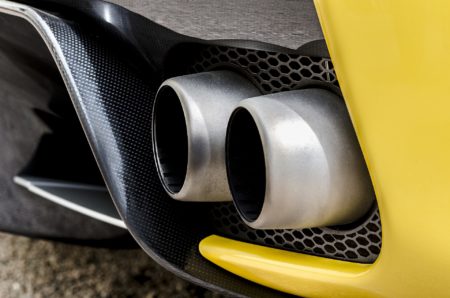 Hot, Hot, HOT!! If you’re well-versed in combustion engines, you likely associate exhaust systems with extreme heat. If you’re also well-versed in gasket materials and how they perform in heat, you likely know that it takes a special material to withstand the conditions present in an exhaust system.
Hot, Hot, HOT!! If you’re well-versed in combustion engines, you likely associate exhaust systems with extreme heat. If you’re also well-versed in gasket materials and how they perform in heat, you likely know that it takes a special material to withstand the conditions present in an exhaust system.
If you aren’t sure about what to look for in an exhaust gasket material, read on to learn how to identify a material that will survive in the exhaust environment.
Ideal Exhaust Gasket Material Characteristics
The harsh environments of exhaust systems can present a challenge if you don’t use acceptable gasket materials. Finding something to withstand the hot gases requires materials specifically designed to survive such conditions. What characteristics should you look for when selecting a gasket material?
1. Metal reinforcement
This provides strength and durability to maintain position in the face of the extreme conditions.
2. Heat-tolerant facing material
Facing material must withstand heat of exhaust without disintegration over the life of the seal. Materials behave differently over time, be sure to choose what is best for you.
3. Abrasion resistance
This might be a factor in joints with high thermal motion, such as joints of dissimilar metals that expand and contract at different rates. In these cases, often a clad-style material is chosen. MTI offers the AR 400 for situations such as this.
4. Low creep relaxation
Graphite products are a good example of a facing with low creep relaxation. This means it will not continue to lose thickness with the heat and time exposure, thus maintaining good flange loading to maintain the seal.
Making Your Decision
As we’ve said before, there is no one perfect gasket material out there for any application. There are a handful of materials that will meet the requirements of an application and it is up to you to decide which one performs best. In order to better educate yourself, you may need to talk to your trusted gasket material supplier and see what they say about a specific material and how it performs in applications similar to yours.
Until next time! If you are interested in subscribing to Sealed-In’s blog posts, email sales@mtigasket.com.

Hot, Hot, HOT!! If you’re well-versed in combustion engines, you likely associate exhaust systems with extreme heat. If you’re also well-versed in gasket materials and how they perform in heat, you likely know that it takes a special material to withstand the conditions present in an exhaust system.
If you aren’t sure about what to look for in an exhaust gasket material, read on to learn how to identify a material that will survive in the exhaust environment.
Ideal Exhaust Gasket Material Characteristics
The harsh environments of exhaust systems can present a challenge if you don’t use acceptable gasket materials. Finding something to withstand the hot gases requires materials specifically designed to survive such conditions. What characteristics should you look for when selecting a gasket material?
1. Metal reinforcement
This provides strength and durability to maintain position in the face of the extreme conditions.
2. Heat-tolerant facing material
Facing material must withstand heat of exhaust without disintegration over the life of the seal. Materials behave differently over time, be sure to choose what is best for you.
3. Abrasion resistance
This might be a factor in joints with high thermal motion, such as joints of dissimilar metals that expand and contract at different rates. In these cases, often a clad-style material is chosen. MTI offers the AR 400 for situations such as this.
4. Low creep relaxation
Graphite products are a good example of a facing with low creep relaxation. This means it will not continue to lose thickness with the heat and time exposure, thus maintaining good flange loading to maintain the seal.
Making Your Decision
As we’ve said before, there is no one perfect gasket material out there for any application. There are a handful of materials that will meet the requirements of an application and it is up to you to decide which one performs best. In order to better educate yourself, you may need to talk to your trusted gasket material supplier and see what they say about a specific material and how it performs in applications similar to yours.
Until next time! If you are interested in subscribing to Sealed-In’s blog posts, email sales@mtigasket.com.

Hot, Hot, HOT!! If you’re well-versed in combustion engines, you likely associate exhaust systems with extreme heat. If you’re also well-versed in gasket materials and how they perform in heat, you likely know that it takes a special material to withstand the conditions present in an exhaust system.
If you aren’t sure about what to look for in an exhaust gasket material, read on to learn how to identify a material that will survive in the exhaust environment.
Ideal Exhaust Gasket Material Characteristics
The harsh environments of exhaust systems can present a challenge if you don’t use acceptable gasket materials. Finding something to withstand the hot gases requires materials specifically designed to survive such conditions. What characteristics should you look for when selecting a gasket material?
1. Metal reinforcement
This provides strength and durability to maintain position in the face of the extreme conditions.
2. Heat-tolerant facing material
Facing material must withstand heat of exhaust without disintegration over the life of the seal. Materials behave differently over time, be sure to choose what is best for you.
3. Abrasion resistance
This might be a factor in joints with high thermal motion, such as joints of dissimilar metals that expand and contract at different rates. In these cases, often a clad-style material is chosen. MTI offers the AR 400 for situations such as this.
4. Low creep relaxation
Graphite products are a good example of a facing with low creep relaxation. This means it will not continue to lose thickness with the heat and time exposure, thus maintaining good flange loading to maintain the seal.
Making Your Decision
As we’ve said before, there is no one perfect gasket material out there for any application. There are a handful of materials that will meet the requirements of an application and it is up to you to decide which one performs best. In order to better educate yourself, you may need to talk to your trusted gasket material supplier and see what they say about a specific material and how it performs in applications similar to yours.
Until next time! If you are interested in subscribing to Sealed-In’s blog posts, email sales@mtigasket.com.
